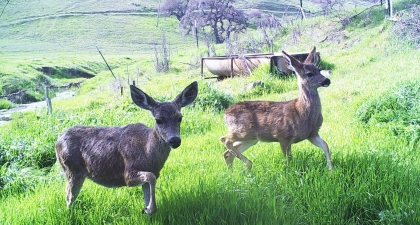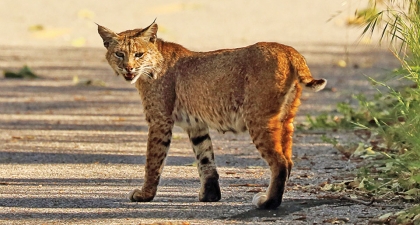Acorn woodpeckers are primarily black, with patches of white on their faces and wings, with a bit of red on their heads. They are found in oak woodlands along the Pacific coast, from Washington to Colombia in South America. True to their name, acorn woodpeckers eat acorns, which they stash in holes they drill in trees. Some of these holes contain thousands of acorns! They also munch on flying insects. Woodpeckers live in communal groups of about a dozen individuals, who contribute by gathering food and raising young. The breeding relationships are complicated, with several males and females mating in each group.
Meet the native American kestrel, the smallest falcon species in North America. American Kestrels are pale when seen from below and warm, rusty brown spotted with black above, with a black band near the tip of the tail. Both sexes have pairs of black vertical slashes on the sides of their pale faces—sometimes called a “mustache” and a “sideburn.” American kestrels mostly eat large insects, also some small mammals, birds, and reptiles. They usually snatch their victims from the ground, though some catch prey mid-flight. American kestrels are found in a range of habitats, including deserts, grasslands, and alpine meadows.
The Anna’s hummingbird is a medium-sized and stocky species of hummingbird, but only weighs 0.1 to 0.2 ounces when full-grown. Anna’s hummingbirds have green backs with greyish feathers below. Like many other species of birds, the males are more brightly colored - they have iridescent red or pink heads and throats, which the females lack. These hummingbirds are common across the West Coast and found in a variety of habitats including oak woodlands, chaparral, scrub, parks, and gardens. You may hear the buzzy or scratchy song of the male hummingbird when he is perched. Their diets consist of nectar and insects as well as the sugar water found in human-made hummingbird feeders.
Barn owls are pale birds with white faces and bodies and tan heads, backs, and upper wings. They have long legs with strong talons, round heads, and dark eyes on their heart-shaped faces. Barn owls are practically silent, flying low across open lands to catch small rodents to eat. These owls have very good low-light vision, but the Barn Owl’s most impressive skill is its ability to track its prey by sound alone. Barn owls nest in a variety of locations, including tree holes, cliff ledges, caves, abandoned buildings, and – you guessed it – barns! You can see them leaving their nests after the sun goes down.
Burrowing owls are found throughout the western United States in open grasslands, although their population has declined due to the loss of open spaces. Visitors to Sierra Vista Open Space Preserve may be able spot these 8-inch tall birds, which have brown-tan splotched feathers and bright yellow eyes. The owls eat a variety of insects and small reptiles including grasshoppers, beetles, crickets, and lizards. Females spend one month incubating about eight eggs each year. During that time, their male partners bring them food.
The red-tailed hawk is a large species of native hawk that thrives in the open grasslands, rolling hills, and oak woodlands of California. Most of these hawks are rich brown when viewed from above and pale when viewed from below. Not surprisingly, the short, wide tails of adults are a rusty red color. Their broad wings allow for high soaring as well as quickly swooping down to capture prey. Their diets mostly consist of small mammals that they hunt in open areas. Red-tailed hawks prefer to perch in high spots – you may likely see one sitting in a tall tree or on a telephone pole. These birds are active year-round and can be spotted in all open space preserves.
Have you ever seen several big, dark birds flying in slow, wobbly circles? Meet the turkey vulture! With huge, dark brown bodies and naked pink or red heads, these common vultures are easy to identify. As carrion birds, turkey vultures don’t kill their own prey, but rather eat already-dead animals. Their feeding habits, large size, and unusual appearance may make them seem scary, but turkey vultures are essential in keeping the environment clean of animal remains. They can be seen at our open space preserves all year round, but you’re most likely to spot them on sunny days.
The Western meadowlark is a robin-sized songbird with a white and brown spotted back, a bright yellow belly and chin, and a black “bib” on its chest. Its name gives away its habitat, for these birds love dry, grassy meadows where they can find insects and seeds to eat. They nest in the grasslands of Coyote Valley and Coyote Ridge open space preserves. If you can’t find one perched, their white outer tail feathers make them easy to spot when they fly. In the spring, you can see the males singing from high bushes or fence posts – listen for the bright, whistling warble.
Yellow-billed magpies are primarily black birds, with long tail feathers, white sides, blue iridescent wing and tail feathers, and their namesake yellow-bill. Although species of magpies are worldwide, the yellow-billed magpie is found only in a small sliver of California’s central valley and coast range, where it lives in oak woodlands. The species is thought to be at risk from climate change due to its restricted range and specific habitat needs, which include mature trees and open grassland. They primarily eat insects such as grasshoppers. Yellow-billed magpies build domed nests out of sticks and mud in a tall tree — about 50 feet off the ground.

























